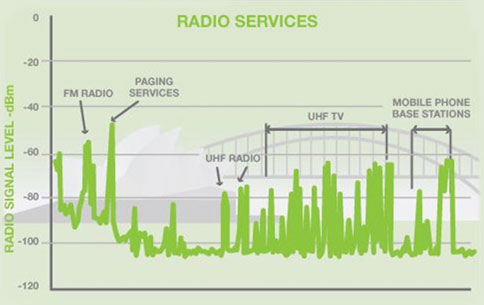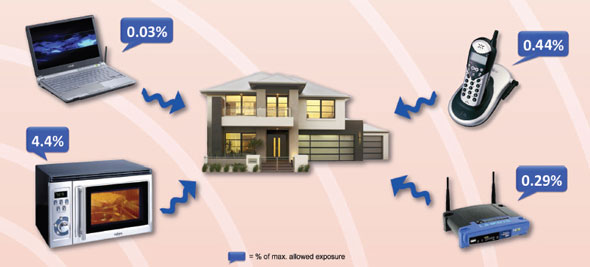Understanding EME
Electromagnetic energy (EME), also known as electromagnetic radiation (EMR) or Electromagnetic Fields (EMF), is the energy stored in an electromagnetic field. It occurs naturally, with the earth, the sun, and the ionosphere all natural sources of EME in our everyday lives.
All forms of EME are collectively referred to as the electromagnetic spectrum. The properties of EME vary with wavelength or frequency, and EME from different parts of the spectrum interact with matter differently. For example, UV light interacts with matter differently to radiofrequency signals.
The electromagnetic spectrum has been harnessed to create a wide range of technologies including radio communications, Wi-Fi, television, electric power, radar, microwave ovens, magnetic resonance imaging, toasters, cameras, lasers and X-ray machines.
The illustration above shows the different technologies using the electromagnetic spectrum. The non-ionizing side of the spectrum shows static electric and magnetic fields from 0 to 50Hz; alternating electric and magnetic fields from 50Hz to 3KHz; TV and radio broadcast, mobile phones (3G, 4G, 5G), microwave and satellite from 3KHz to 300GHz; and visible sunlight from 300GHz to 3000THz. The ionizing side of the spectrum includes ultraviolet light, X-rays and radioactive sources ranging from 3000THz to 30EHz.
Mobile phone frequency 700MHz – 3600MHz, mmWave 26-28GHz
The word "radiation" often brings to mind radioactive materials and x-rays. However, radiofrequency EME does not behave like the radiation from radio active material or x-rays. Radiofrequency EME is transmitted by communications systems as radio waves - electromagnetic waves that have the capacity to transmit sound, music, speech, pictures and other data invisibly through the air.
All radio communications systems use EME in the radiofrequency (RF) part of the electromagnetic spectrum between 3 kilohertz (kHz) and 300 gigahertz (GHz). These include TV, AM and FM radio broadcasting, mobile phones and their base stations, paging services, cordless phones, baby monitors, and emergency and rural communications systems.
Source: EMF Explained 2.0
The illustration above shows typical radio communication systems in a community. One radio network system in an urban area connects to hospitals with smart health, schools, stadiums, smart utilities, small businesses, large businesses and smart homes. Another radio system in a rural area connects to remote management, smart farms, safe vehicles and shopping centres.
People have been living with radiofrequency energy in their environment for generations. In fact, the principles and technologies of radio communications date back to the 1880s with the invention of "the wireless”.
EME in the Environment

The illustration above shows the various radio communication signals measured in a typical community. FM radio and paging services measure between -40 to -60dBm, UHF radio, UHF TV and mobile phone base stations measure between -60 to -80dBm.
This picture is a plot from a spectrum analyser (specialised radio measurement equipment) showing the various radio communications signals measured in a typical community. The plot is taken at one location to illustrate typical radio communication signals present.
This plot shows that the environmental EME levels from mobile base stations are like other radio services in the community.
Information on environmental EME levels measured in Australian schools is available from the Australian Radiation Protection and Nuclear Safety Agency (ARPANSA) web site
This infographic shows the typical public radio frequency EME exposure levels relative to the ARPANSA public safety standard from a range of sources including radio and TV broadcast, Wi-Fi and mobile networks.
EME in the home

Many devices in the home use EME to operate, including cordless phones, baby monitors, Wi-Fi routers, microwave ovens and wireless keyboards.
The illustration above from the Australian Centre for RF BioEffects Research (ACRBR) shows the maximum allowed EME exposure levels of common devices as a percentage. Laptop computer: 0.03%, Microwave: 4.4%, wireless home phone: 0.44%, wireless router: 0.29%. 100% = the maximum public exposure limit.
Baby monitors are also common devices in homes, and testing shows the EME levels from baby monitors range from approximately 33% to 1% of the public exposure level over 20-100cm.
Reference: ACRBR survey in Australian homes
Baby monitors are also common devices in homes and testing shows the EME levels from baby monitors range from approximately 33% to 1% of the public exposure level over distance of 20-100cm from the monitor.
Radiofrequency in History
| Year | Milestone |
|---|---|
| 1895 | Guglielmo Marconi transmits his first radio signal |
| 1906 | Lee De Forest invents AM radio |
| 1920s | AM radio commercially broadcast to mass audiences |
| 1925 | John Logie Baird and Charles Jenkins experiment with television - transmitting the first live pictures |
| 1930s | FM radio is commercially broadcast United States Navy pioneers military radar technology |
| 1956 | Black and white TV is introduced to Australia Robert Adler invents the first remote control, the "Zenith Space Commander" |
| 1973 | Martin Cooper makes the first ever call on a hand-held mobile phone |
| 1975 | Colour TV is introduced to Australia |
| 1981 | Telstra introduces the first mobile telephone system to Australia - the MTS007 system using car phones |
| 1987 | Telstra introduces the analogue mobile phone network to Australia - the AMPS or Advanced Mobile Phone System |
| 1993 | Telstra introduces the first digital mobile network to Australia - the GSM or Global System Mobile network |
| 1999 | Telstra introduces the first CDMA (Code Division Multiple Access) mobile technology to Australia |
| 2000 | The AMPS mobile network is turned off and CDMA expanded to rural areas |
| 2003 | Telstra introduces the first third generation mobile network on CDMA |
| 2006 | Telstra introduces Australia's largest and fastest national third generation mobile network, the Next G™ network |
| 2008 | The CDMA mobile network is turned off and the Next G™ network continues to be expanded |
| 2011 | Telstra Introduces Australia’s first fourth generation LTE 1800MHz mobile network |
| 2014 | Telstra Introduces the LTE Advanced 4GX mobile network and a national Wi-Fi network |
| 2016 | GSM Network de-commissioned |
| 2016 | Conducted Australia’s first 5G live field trial |
| 2017 | GSM Network de-commissioned |
| 2018 | Telstra opened our 5G Innovation centre at Southport Exchange on the Gold Coast |
| 2019 | Telstra introduces 5G on 3.5 GHz frequency range |
| 2020 | Telstra launched 5G mmWave technology at 26GHz frequency range |
You can find all licensed radio communications in Australia on the Australian Communications and Media Authority (ACMA) Register of Licensed Radio communications.
Mobile phones use a low-powered radio signal to communicate with the mobile and public telephone networks. Mobile network base stations also transmit and receive low-powered radio signals to communicate with mobile phones.
The health impact of these radio signals is assessed in two ways. Firstly, it is assessed in terms of the direct impact on the mobile phone user. Secondly, it is assessed in terms of the ambient impact of radiofrequency signals in the environment on the general public.
For a mobile phone, mandatory safety standards limit the amount of radio frequency energy that can be absorbed in a person’s head or body. For a base station, mandatory safety standards limit strength of the signal (or radiofrequency EME) that people can be exposed to in publicly accessible areas.
For a mobile phone, mandatory safety standards limit the amount of radio frequency energy that can be absorbed in a person’s head or body. For a base station, mandatory safety standards limit strength of the signal (or radiofrequency EME) that people can be exposed to in publicly accessible areas.
In Australia mobile network communications are regulated by the Australian Communications and Media Authority (ACMA). For the safety standards for mobile communications and other radiofrequency signal transmissions, ACMA takes advice from the Australian Radiation Protection and Nuclear Safety Agency (ARPANSA).
Safety standards are based on careful analysis of the scientific literature (both thermal and non-thermal effects) and are designed to offer protection against identified health effects of EME with a large in-built safety margin.
Since 2002 Australia's safety standard has been based on the safety standard recommended by the World Health Organization (WHO).
Rather get in touch? Let's get you connected
Online help & support
Find answers to your frequently asked questions.
Sign in to the My Telstra app
View your services, pay your bill, troubleshoot tech issues, contact us via chat and much more.
Multilingual support
Speak with us in your preferred language. We've got you covered.
Reach out to us
We're here to answer your questions.
